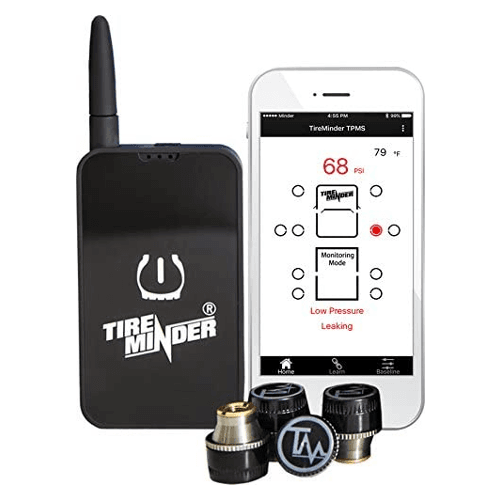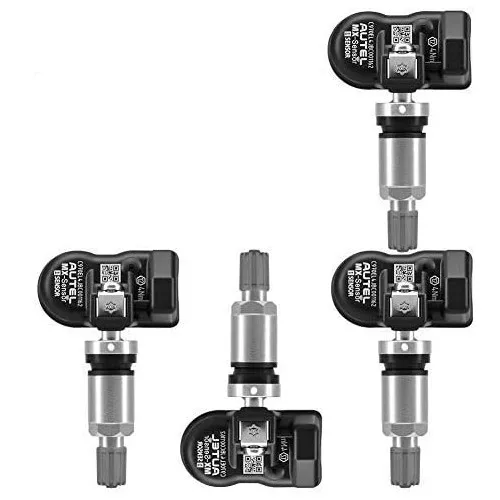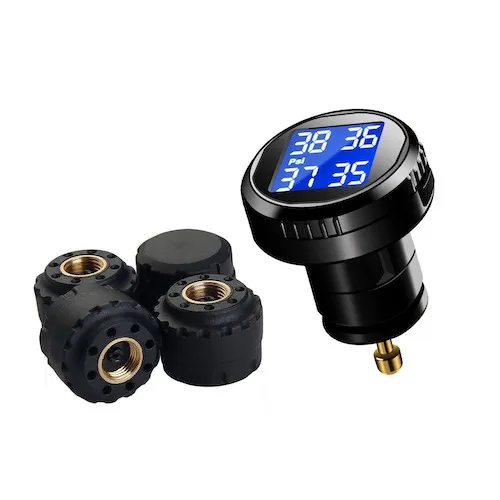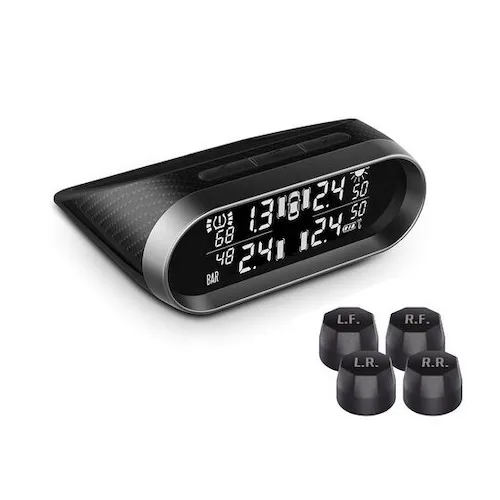Top Pick for
Overall tyre pressure monitoring system


Top Pick for
Overall tyre pressure monitoring system

Top Pick for
Indirect tyre pressure monitoring system

Top Pick for
Wireless tyre pressure monitoring system

Top Pick for
External tyre pressure monitoring system

A tyre pressure monitoring system (TPMS) is a handy tool that keeps track of your tyres' pressure levels. It is specifically designed to monitor the air pressure inside the tyres of cars, trucks, trailers and even motorcycles. Your TPMS lets you know when your tyre pressure drops or when the tyres are under-inflated.
To find the best TPMS for your need, consider if you want an indirect or direct model. Direct tyre pressure monitoring systems monitor the air pressure inside your car tyres while indirect TPMS uses your vehicle's anti-braking system (ABS) to keep track of tyre air pressure. You should also consider the number of sensors, ease of use and durability when choosing a TPMS.
For this list, we evaluated tyre pressure monitoring systems from brands such as Promata, Vesafe and TireMinder. We picked options based on customer ratings and reviews. For each category, we also considered each product's key features.
Read more detail on our methodology below.

For the best overall tyre pressure monitoring system, we picked the TireMinder Smart TPMS, which has a rating of 4.3 out of 5 stars on Amazon.
This smart TPMS can monitor up to 22 tyres and has 0.5oz transmitter screw-on valve stems. It comes with a companion mobile app compatible with iOS and Android devices with Bluetooth 4.0 connectivity. The kit has visual and audible high/low leaking alert and high-temperature alarms, plus batteries, O rings, anti-theft locking nuts and a carrying case.
Customers were impressed by the product's ease of use, versatility and accuracy. While it's not the easiest to pair with mobile phones, its accompanying app is user-friendly, allowing you to monitor your tyre pressure anytime, anywhere. Installing the valves is a breeze too. Users added that this device doesn't produce false signals for the most accurate and reliable results possible.

For the best indirect TPMS, we recommend Autel's MX-Sensor 2-in-1 100% Cloneable TPMS programmable sensors. On Amazon, customers gave it a rating of 4.3 out of 5 stars.
Autel's indirect tyre pressure monitoring system is a universal device suitable for most vehicle types and models. It features a sensor with both 315MHz and 433MHz frequencies, which means it can work on any TPMS-equipped vehicle with no relearning required. The brand also claims it is "100% cloneable with the original sensor ID".
Because this is an indirect tyre pressure monitoring system, it detects a low tyre by evaluating wheel speeds using your car's ABS. It is equipped with an automotive-grade battery for long-lasting use and can withstand extreme conditions. Users said it is easy to install too. Some added that it produces consistent and reliable results, allowing them to be on the road with peace of mind. However, this requires programming to work for specific vehicles.

With a rating of 4.4 out of 5 stars on Amazon, we chose the EEZTire Real-Time Tyre Pressure Monitoring System for this category.
This TPMS claims to accurately monitor tyre pressure and temperature for up to 26 tyres and can handle pressure of up to 210PSI. It features motion-sensitive monitors that continuously read your tyre's pressure at 6-second intervals. It then sends a visual and audio warning when the pressure or temperature falls outside preset safety parameters. This system includes a monitor with a 4-inch screen for easy monitoring.
A versatile and handy system, this tool is easy to set up and program. It also offers separate controls for RV and trailer sensors, allowing you to turn off trailer controls when driving an RV. The monitor is also user-friendly, offering great feedback when monitoring and adjusting tyre pressure. However, some customers said the system tends to lose the sensors' signals, which sometimes leads to inaccurate readings.

For the best wireless TPMS, we picked the Vesafe Tyre Pressure Monitoring System. It has a rating of 4.2 out of 5 stars.
This Vesafe tyre pressure monitoring system provides real-time pressure and temperature monitoring for 4 tyres. It comes with a user-friendly display monitor, providing both visual and audible alerts when tyre pressure or the temperature falls beyond the set thresholds. The sensors are also designed with anti-theft and waterproof sensors. You also get special tools for installation and an 18-month warranty.
The general sentiment is that this is a decent option if you're on a budget. It is easy to install and even comes with a replacement sensor battery as a backup. The system is also universal, which means it suits a wide range of vehicle types. Customers said it provides accurate results that are easy to read. Some loved that it automatically updates the reading immediately as soon as the car moves. The display screen looks and feels a bit cheap, but this seems to be a minor concern.

Oricom's TPS9I Internal Tyre Pressure Monitoring System is our choice for the best internal tyre pressure monitoring system. This is a solar-powered system with wireless transmission and an adjustable threshold value.
The TPS91 has tyre pressure sensors installed within the tyres themselves. The system features wireless and accurate transmission between the sensor and the display unit for real-time monitoring. It also has visual and audio alerts when the tyre pressure or temperature falls beyond the preset threshold. It comes with a 12-month warranty as well.
This Oricom TPMS is compact and easy to use with an operating frequency of 33.92MHz ±0.05MH. It also has a battery life of 5 years and a solar-powered unit for long-lasting use. Customers said the display is easy to read, providing consistently accurate measurements. Installing the internal sensors is a bit more difficult compared to other types of TPMS, but this doesn't seem to bother buyers.

For the best external option, we recommend the Promata External Tyre Pressure Monitor. This unit is a DIY system with a solar-powered display and 4 external sensors.
This Promata TPMS is designed for 4-wheel-drive vehicles with the Aussie outback in mind. It offers real-time monitoring and comes with IP67 water-resistant and dustproof sensors. The system has wireless transmission within a 10-meter range.
At less than $200, this is a pretty decent and reliable system suitable for a wide range of vehicles. It is easy to install and can be used to monitor up to 10 tyres. The system also has a user-selectable pressure alarm and an easy-to-read display. A critic mentioned that the display doesn't seem to give out any reading when the temperatures are quite high, but this seems to be an isolated issue.
For this list, we evaluated various tyre pressure monitoring systems from the following brands:
We then made a list based on customer ratings and reviews as of June 2022. We also considered each TPMS's key product features, including price, pressure range, number of sensors and ease of use. We came up with what we believe are the 6 best tyre pressure monitoring systems available online.
The TPMS or tyre pressure monitor (TPM) is an electronic system designed to monitor the air pressure inside the tyres of cars, trucks, caravans, trailers and other vehicles. When tyre pressure drops dangerously low, your TPMS will alert you that one or more of your tyres is under-inflated.
A TPMS helps prevent accidents caused by under-inflated tyres. It also ensures that you can temporarily repair your tyre with a plug or fit a spare before the under-inflated tyre is permanently damaged. Real-time tyre pressure information is relayed to the driver via a gauge, screen display or low-pressure warning light.

Real-time pressure monitoring provides immediate feedback on your tyres' condition and will alert you if your tyre pressure is dangerously under-inflated.
An under-inflated tyre flexes more than a correctly inflated tire, creating excess heat that can break down components inside the tyre. If the tyre is bent far and long enough, it will heat up and snap. Your tyres may be at higher risk in hot summer weather or if driving at high speeds.
Here are 4 reasons to buy a TPMS:
If your car is already fitted with a TPMS, you probably won't need to purchase another one. However, the installed TPMS may not be the best choice for your needs. Read on to find out what options are available.
Generally, whether your car is already fitted with TPMS depends on when and where your car was manufactured. The following regulations apply:
Keep in mind that there are no regulations requiring a TPMS for vehicles over 4.5 tonnes.
If you are still unsure as to whether your car is fitted with a TPMS, check your vehicle's manual or consult your vehicle dealer or tyre expert.
A TPMS is only there to warn you of a tyre puncture or active air leak. It is not a substitute for regularly checking your tyre pressure to ensure it is maintained at the optimal level.
To find out the recommended pressure for your car, check out the placard on the driver's or passenger's door jamb, boot lid or in your owner's manual. If you cannot find it, consult your vehicle dealer, the manufacturer or a qualified tyre professional.
You can't tell just by looking at your tyre whether it is under-inflated. A tyre pressure gauge is a simple and cheap manual device used to accurately measure the pressure inside tyres. For more information, check out our guide to tyre pressure gauges.
Deleted: Car servicing guide
A TPMS can be built into your vehicle when it is manufactured or added on separately after purchase. There are 2 main types of TPMS: indirect and direct. Direct systems are further divided into internal and external versions.
To find out if your vehicle comes with a direct or indirect TPMS, check the inside of the tyres. If you are not sure, ask a mechanic to take a look. Cars made in the US from 2008 onwards have direct systems.
Indirect pressure monitoring uses your car's built-in anti-lock braking system's wheel speed sensors. Because an under-inflated tyre has a smaller circumference, it will have to move faster to keep up. When the sensor detects that one tire is rotating faster, the pressure warning system activates.
Direct pressure monitoring actually measures the tyre pressure and temperature. A gauge is mounted to the tyre valve or inside of the wheel, which sends a signal to the car's computer.
There are 2 kinds of direct tyre pressure monitors. Internal TPMS have sensors that are attached inside the wheel well or mounted to the tyre valve stem. External TPMS replace the existing valve cap and are simply screwed into place. They have a locking system to prevent theft or tyre loosening and wirelessly communicate actual pressures to your car display via Bluetooth.
| Pros | Cons | |
|---|---|---|
| Internal (in-wheel) |
|
|
| External (valve-cap) |
|
|
While you can get a TPMS for under $100, a high-quality TPMS with 4 sensors will cost you $300 or more.
Once you've determined the type of TPMS you want and how much you're willing to spend, consider the following essential features:
Ensure you pick a TPMS that suits your vehicle's pressure range. While regular 4-wheel cars operate at 25–40PSI, 4WDs may operate at low pressures under 20PSI while some caravans and trailers require over 50PSI.
These can range from 4 to 20. If you have a tow vehicle or trailer, look out for products that have additional sensors so you can monitor the pressure on your vehicle and trailer.
You may need extender units for trailers, caravans and towing vehicles when the range of the wheel sensor is limited due to distance.
If you are an adventure enthusiast, it's important to consider if the system can withstand overheating and harsh environments and if it's waterproof.
Some TPMS models come with temperature sensors to ensure your tyres don't become too hot or cold.
Additional factors to consider:
To work out which TPMS is best for you, you should first consider the type of vehicle you are driving.
If you have a regular 4-wheeled vehicle, the cost and number of features included affect your choice of an indirect, direct internal or direct external TPMS.
If you have a 4WD, caravan, trailer or towing vehicle, you should be prepared to spend more on a TPMS that caters for additional sensors, a wider pressure range and extender units.
These are the best car roof racks you can buy right now in Australia.
These are the 6 best tyre pressure gauges you can get right now in Australia.
How to choose a car GPS that best suits your needs.